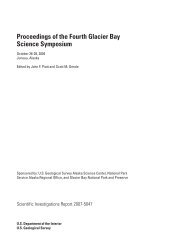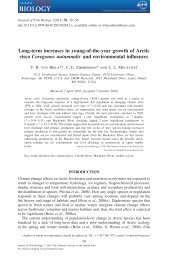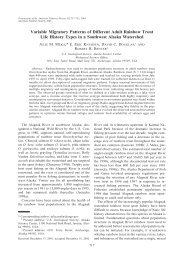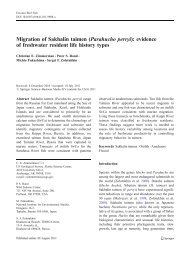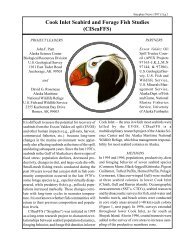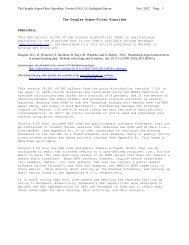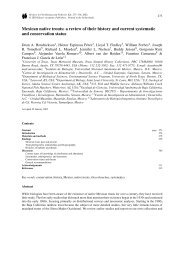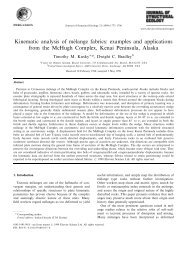Kline, T. C., C. A. Woody, M. A. Bishop, S. P. Powers, and E. E. ...
Kline, T. C., C. A. Woody, M. A. Bishop, S. P. Powers, and E. E. ...
Kline, T. C., C. A. Woody, M. A. Bishop, S. P. Powers, and E. E. ...
Create successful ePaper yourself
Turn your PDF publications into a flip-book with our unique Google optimized e-Paper software.
ASSESSMENT OF MARINE-DERIVED NUTRIENTS IN THE COPPER RIVER DELTA<br />
as little as 1 month (<strong>Kline</strong> <strong>and</strong> Willette 2002;<br />
Hicks et al. 2005), a given sample will reflect<br />
a feeding diversity when individuals<br />
are mobile, as out-migrating salmon are, if<br />
they had arrived at the sampling location<br />
within weeks from mdn-diverse feeding areas<br />
in the watershed.<br />
Biota (e.g., periphyton <strong>and</strong> juvenile<br />
salmon) in the CRD watershed were generally<br />
15N-enriched similar to previous studies. A<br />
few of the salmon, however, had relatively low<br />
values as did control <strong>and</strong> coho-only periphyton.<br />
Biota in sections of Sashin Creek <strong>and</strong> portions<br />
of the Kvichak watershed accessible to<br />
anadromous salmon were δ15N enriched by<br />
4.1–5.4 0 / 00 relative to salmon-free areas (<strong>Kline</strong><br />
et al. 1997). Studies outside of Alaska have<br />
also produced similar results. For example,<br />
Reimchen et al. (2003) showed that insects,<br />
soil, <strong>and</strong> riparian vegetation were 15N enriched<br />
in the spawning sections of several<br />
Vancouver Isl<strong>and</strong> streams <strong>and</strong> that the enrichment<br />
was proportional to salmon density. A<br />
key factor in these studies has been systematic<br />
sampling to address the considerable spatial<br />
<strong>and</strong> temporal variability in occurrence of<br />
spawning salmon. Low trophic level biota that<br />
grow attached to substrates, periphyton, confer<br />
the advantage of a fixed spatial context in<br />
moving waters. The U.S. Environmental Protection<br />
Agency recommended sampling device;<br />
the WPS was successfully deployed<br />
in streams, as well as lentic water bodies,<br />
for the time periods specified in Table 1,<br />
enabling both temporal control <strong>and</strong> consistency<br />
in substrate. Periphyton grew well<br />
on the glass microscope slides used in the<br />
WPS producing substantial material for analysis,<br />
in proportionate response to localized<br />
effects of marine nutrients (Mathisen 1972;<br />
<strong>Kline</strong>, unpublished).<br />
No single isotope was superior for quantifying<br />
the effects of mdn. When MDC is remineralized<br />
to CO 2 , it can exchange with the<br />
atmosphere. Carbon is thus only conserved<br />
through the DP, thus excluding the RP.<br />
Reduction of sulfur was potentially a source<br />
of significant δ34S variation of the TEM, <strong>and</strong><br />
thus uncertainty in MDS precision. Whereas<br />
δ15N may have had a more consistent TEM<br />
compared to δ34S, trophic level assumptions<br />
can have a pronounced effect for estimating<br />
MDN for consumer trophic levels (<strong>Kline</strong><br />
2003). Thus, there may be no point for<br />
presently calculating MDN, MDS, or MDC<br />
for fishes in this system, especially given that<br />
stable isotope values existed in a range without<br />
apparent central tendencies. Central tendencies<br />
may be more likely in systems with a<br />
well-mixed reservoir of N or S, such as a large<br />
lake. The range in values observed here suggests<br />
that fish use a range of disparate habitats<br />
containing a wide range of mdn. This<br />
may reflect that the system is space-limited so<br />
that juvenile salmon essentially fill every<br />
nook <strong>and</strong> cranny they can access. Utilization<br />
of space could vary with time <strong>and</strong> be revealed<br />
by redistribution of isotopic values. For<br />
example, access may be seasonally blocked<br />
by ice or low water levels, which may be<br />
revealed by seasonal shifts in the range of isotopes<br />
observed. Anthropogenic changes to<br />
the environment may also prevent salmon<br />
from accessing portions of the watershed.<br />
Such changes in the habitat may be revealed<br />
by losses or gains in the observed range of<br />
isotope values. The diversity of habitat use<br />
<strong>and</strong> food webs revealed by isotope values<br />
may thus be more important for salmon conservation<br />
than mdn per se.<br />
Acknowledgments<br />
Primary funding was provided by the Watersheds<br />
component of the Gulf Ecosystem Monitoring<br />
program of the Exxon Valdez Oil Spill<br />
Trustee Council with additional support<br />
through the U.S. Geological Survey, North<br />
Pacific Research Board <strong>and</strong> the Oil Spill Recovery<br />
Institute. Richard Doucett, Colorado<br />
59




